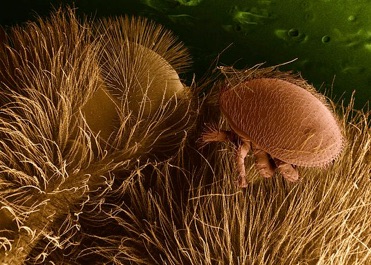Honey bee defences against diseases






Honey bees have three levels of defence against disease.
The honey bee colony is considered to be a super-organism since a bee colony often acts as a single unit to share labour, specialise in tasks, and coordinate efforts (Chen & Siede, 2007). So the first level of defence acts at the level of the colony. We can consider in this level (Fries and Camazine, 2001):
-
•Grooming and allogrooming: the behaviour of bees in cleaning themselves or other bees from dirt and parasites.
-
•Cell cleaning: bees routinely clean the cells before storing new resources. They also clean as well cells that contain infected or dead bee

Fig 1: Bee grooming (author: kd kelly)
larvae.
-
•Undertaker bees: these bees throw dead bees, larvae and other insects out of the nest.
-
•Use of antibacterial substances such as propolis: this material is used not only to seal eventual fractures in the hive, but also as an isolation material to cover and mummify enemies that honey bees have previously killed in the hive. These can be as large as a mouse.
Second level defences are the mechanical/chemical barriers to infection of the bee itself (Evans et al., 2006, Chen & Siede, 2007). We can consider in this level:
-
•Exoskeleton: made of chitin, physically separates the internal organs from the environment and from pathogens. Figure 2 shows a electron microscopy. picture of a varroa on a bee.
-
•Chitinous linings of trachea: reduce the possibility of infection from airborne disease agents.
-
•Peritrophic membrane: a chitinous membrane lining to the midgut. This keeps pathogens in the alimentary tract and prevents them from entering the haemocoel through the gut wall.
-
•Biochemical environment of the gut: prevents the growth of many bacterial species. In fact antimicrobial substances are present in ingested food (honey), and different proteolytic enzymes are secreted in the gut.
-
•Antibiotic system in pollen and honey and royal jelly: the chemical characteristics of these foods such as the Water Activity (AW is the percentage of water in the food not bound to chemical substances available to be utilised by other organisms such us bacteria), pH and presence of antibacterial substances as glucose oxidase keep it free from pathogenic bacteria.

The third level of defence is the immune system. Insects lack an immunoglobulin-based immune response characteristic of higher animals; natural killer cells, antibodies, cytotoxic T cells and memory cells are all lacking and immunity in the insect is based solely around the innate immune system (Chen & Siede, 2007). Nonetheless this type of response may still be divided into cellular and humoral arms.
1 Cellular immune response: the primary goal of this response is the differentiation between self and non-self molecules and thus the recognition of pathogens. The binding of the haemocytes to the pathogen leads to the first cellular reaction, phagocytosis. When the number of pathogens is high nodule formation may result from the
Fig 2: Low temperature scanning electron micrograph of V. destructor on a honey bee host
cooperation of many haemocytes. When the pathogen is very large, for example a parasite, and cannot be phagocytosed, the cellular response leads to encapsulation (multilayer of haemocytes and melanin) (Chen & Siede, 2007).
2 Humoral immune response: this system involves secretion of antimicrobial peptides by fat bodies (equivalent to the mammalian liver) into the haemolymph (Chen & Siede, 2007). Their expression is regulated by two signalling pathways, the Toll pathway and the immune deficiency (Imd) pathway (Bulet et al., 2004). The Toll pathway is activated in Gram-positive infections and the Imd is activated in Gram-negative infections. A third pathway, the Janus-Kinase signal transduction (Jak-STAT) pathway seems to be involved in the response to viral infection but further studies are required to fully understand how insects can combat viral disease. (Evans et al., 2006)



Citation: Cordoni, G.; 2011. Epidemiology and taxonomy of honey bee viruses in England and Wales. PhD thesis. University of Surrey.
Developed by
Dr. Guido Cordoni DVM, PGDip, PhD, MRCVS